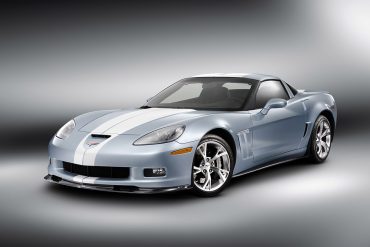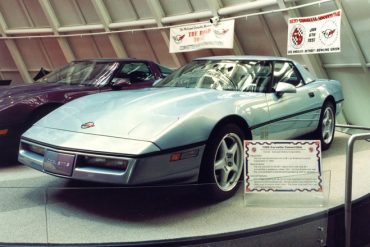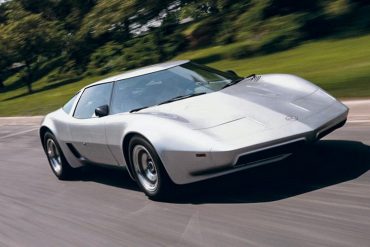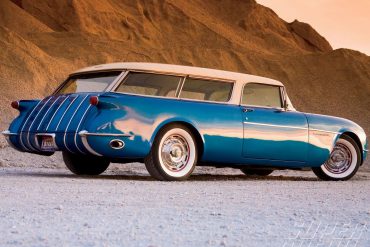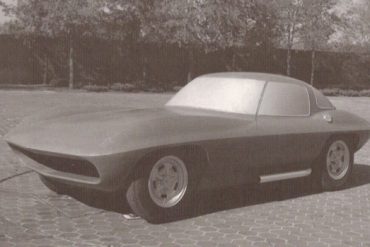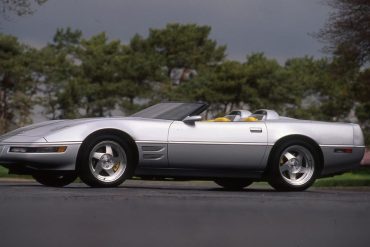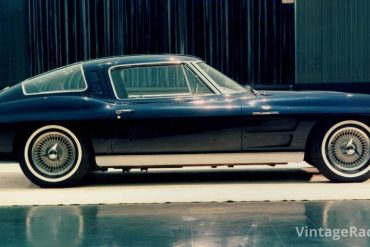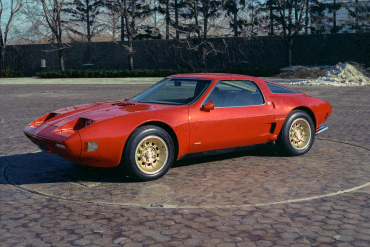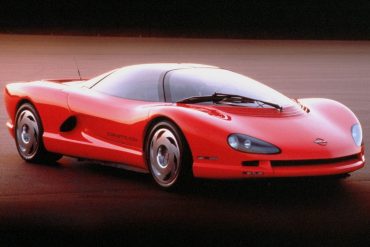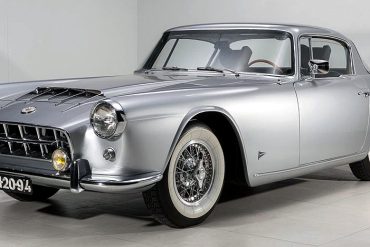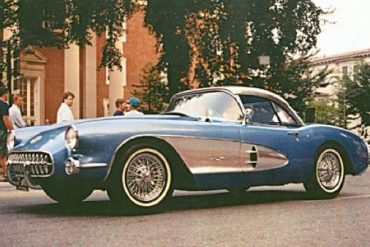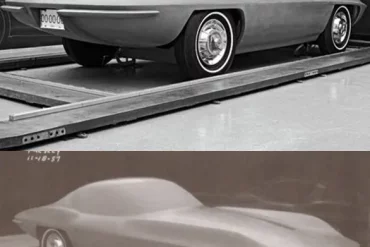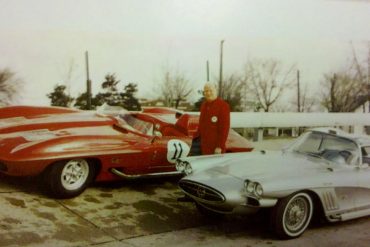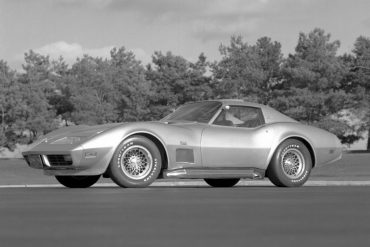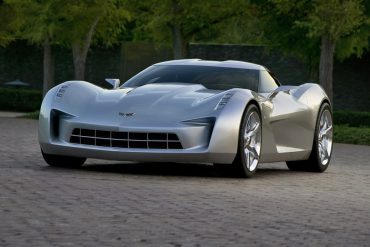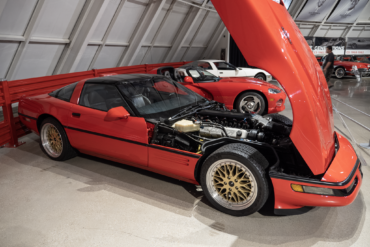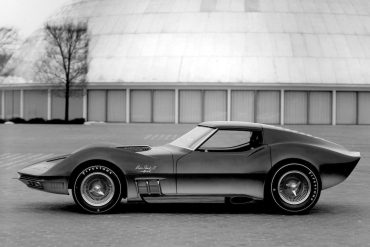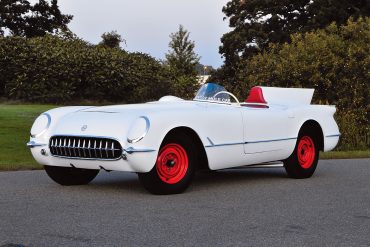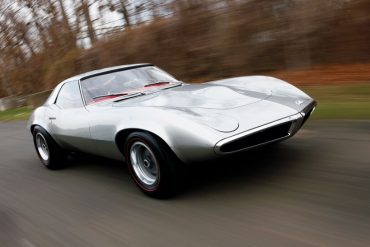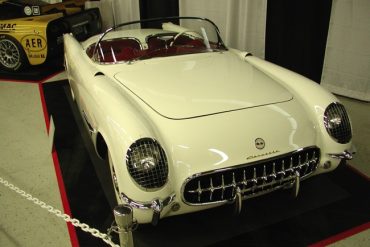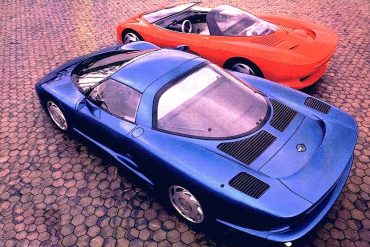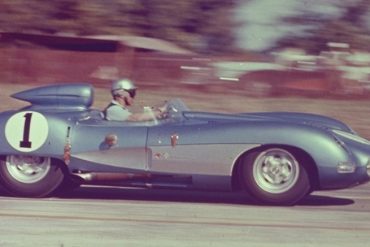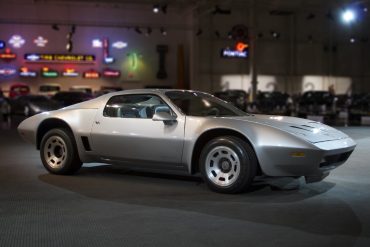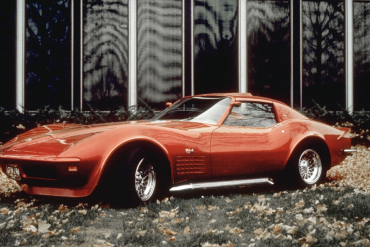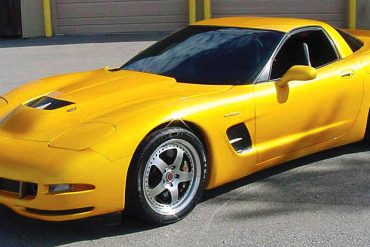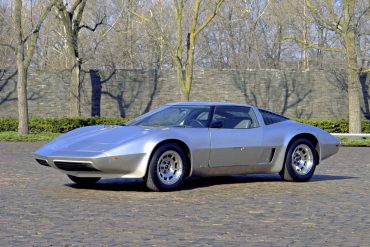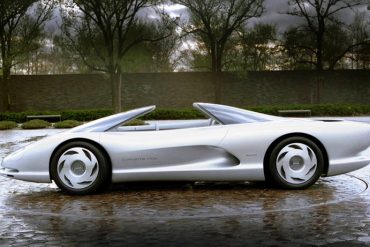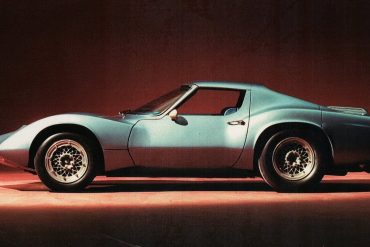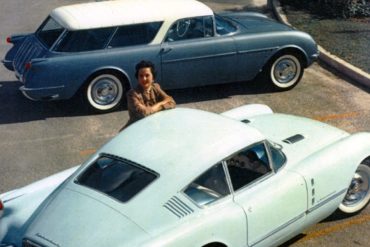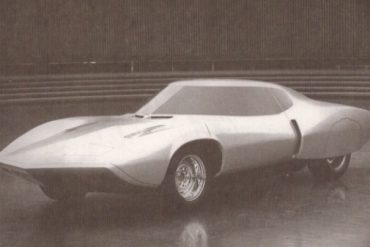The Carlisle Blue Grand Sport Concept is painted in a very cool Carlisle Blue exterior with exquisite Pearl White full-length racing stripes. This color combination is highlighted with Silver-painted Torque 2 wheels. The Corvette also benefited from carbon fiber front splitter and rockers, a full-width rear spoiler, and a Grand Sport style hood blanket. For the interior, Chevrolet has opted for Ebony/Titanium leather with blue stitching, a new Bose Premium Audio with nine speakers.
There were several successful attempts to build a convertible ZR-1, most of them by private people. The DR-1 was a GM prototype to test the structural integrity of the ZR-1 chassis when it would be topless. The car was built by American Sunroof Corporation (ASC) for Don Runkle, who was the vice-president of Advanced Engineering Staff, which explains the “DR-1” designation. It was a standard convertible transformed to ZR-1 specs.
The Chevrolet Aerovette (originally designated Experimental Project XP-882) was developed in the late 1960's under the watchful eyes and mind of Zora Arkus-Duntov. Unlike the XP-819, which ultimately proved to have too much rear weight bias, Duntov focused on developing the Aerovette as a mid-engine platform.
Carl Renner was responsible for the Nomad which was essentially a Corvette built with an extended station wagon roof. This meant the Corvette shared its lightweight fiberglass body, ‘Blue Flame’ inline-6 engine and curvaceous styling with the Nomad.
Somewhere in the second part of 1959, project XP-720 begins at GM Styling, to design a production Corvette based on Bill Mitchell's Sting Ray racer. It would become known as the C2 or second generation Corvette. In October of that same year, a clay mock-up of project XP-720 is completed and put on display for General Motors' management viewing.
Chevrolet Corvette ZR-1 Spyder prototype, 1991, by ASC. An experimental styling prototype ordered by Don Runkle, Chevrolet’s chief engineer, to see how far the ZR-1 might be pushed in convertible form. The windshield was chopped in half and the seats were mounted directly to the floorpan. The black example in the National Corvette Museum was originally painted Sebring Silver with a Neutrino Yellow interior.
The Stingray that never was. The stretched version of this new Corvette model for 1963 has rear seating and was built as ordered by Chevrolet chief Ed Cole. Larry Shinoda designed this coupe, that never went into production because the demand for the two seated Stingray already was overwelming. A running prototype of a 2+2-seat C2 Corvette intended to compete with the Ford Thunderbird was built, but the project was canceled.
This little concept mounted a 180-horse Wankel transversely, driving a new automatic transaxle being developed for the forthcoming X-body Citation. Designed by GM's Experimental Studio and built in 6 months on a modified Porsche 914 chassis by Pininfarina, the 2-Rotor made its debut at the 1973 Frankfurt show.
The 1986 Corvette Indy Prototype was developed beyond clay modeling to the point of a fully-functioning, drivable car, though it was clearly understood that this car would never evolve beyond the prototype stage. Like the clay mock-up before it, development of the mid-engine Indy prototype began in 1985, pulling design cues from its predecessor.
Chevrolet Corvette Coupé, 1957, by Ghia Aigle. Designed by Giovanni Michellotti a one-off built on a ‘54 Corvette chassis by Carozzeria Ghia in Switzerland. The Ghia Corvette was powered by a Blue Flame 6 in-line engine with a 4-speed manual gearbox
If you were a senior GM employee, one of the perks was being able to have your own custom built for you. Bill Mitchell was known for it, but this SR-2 Lookalike was built for GM president Harlow Curtis, who was president of GM during the period that the SR-2 were developed. The lookalike was built by GM’s styling staff and presented to him.
Duntov laid out three design concepts that took decades to implement. The first was his proposal for the 1957 Q-Corvette. This design called for the following: an all-aluminum, fuel-injected small-block engine, four-wheel independent suspension, four-wheel disc brakes, and a transaxle. This design concept arrived in 1997 as the C5.
Designed and built under the personal supervision of Bill Mitchell, the wild-looking XP-700 used many regular Corvette components (frame, chassis parts and engine). Bill Mitchell had a lot of “customs” built for himself. This XP-700 previewed the new tail of the upcoming 1961 Corvette.
Chevrolet Corvette Mulsanne Showcar, 1974. Created by Bill Mitchell, the Mulsanne was a development of several previous Corvette “specials”, the 1969 Aero and the 1970 Scirocco. By 1974 it had been bored out to 454 ci and fitted with an experimental Rochester fuel injection system, it also had a periscope rearview mirror system.
SIDESWIPE takes the form of a sleek, vision concept dreamed up by the Corvette designers at GM. The design is influenced by the original Stingray race car, introduced in 1959, but also draws on Corvette heritage cues from other generations. It brings them together in a futuristic shape that seems to be equal parts racecar and space ship.
The Corvette team decided to one-up the Viper with four extra cylinders, they decided on one of Ryan Falconer’s stunning, all aluminum, 600-cubic-inch, 683hp, 680 lb-ft V-12 racing engines. The biggest challenge was the fact that the all-aluminum V-12 engine was 8.8-inches longer than the production Corvette engine. So the front end of the ZR-1 would have to be stretched 8 inches. This test car was named Conan, after his raw, beastlike charisma.
The Mako Shark II was a radical concept that shaped Stingray years later. While showcasing distinct design cues, the Mako Shark contained many notable features for 1965. It had a one-piece front-end that hinged forward for access to the engine bay, a removable hardtop, knock-off aluminum wheels and a big-block 427. Chevrolet received overwhelming requests to have it produced.
Built for outright top speed, this prototype Corvette was built by Zora Duntov. He successfully piloted the car to a two-way average speed of 150 mph in January of 1956 at Daytona. Later two more similar cars were built for the 1956 Daytona Speed Weeks in February. After initial resistance from Engineering, Duntov’s cam was delivered to the Proving Ground.
When first introduced to the world by Pontiac in 1964, the car showed so much promise that Chevrolet (allegedly) put a swift end to its development to prevent its production from hindering the sales of the Corvette. Afterall, with the introduction of the 1963 Split-Window Corvette, Chevy was finally seeing an increase in sales, something lacking for most of the first-gen.
Based on Harley Earl’s Project Opel plaster model, the EX52 / 122 was the original concept car that inspired the nation and left countless consumers wanting a Corvette to call their own. This Corvette concept was introduced at GM’s Motorama in January 1953.
While it was understood that the Corvette Indy Concept would never be fully realized as a production vehicle, it paved the way for the creation of the twin-turbo CERV III. The CERV III (Chevrolet Engineering Research Vehicle No. 3) was introduced in January, 1990 at the International Auto Show in Detroit, Michigan. Like the latter iteration of the Corvette Indy Concept car, the CERV III was fitted with a 5.7 Liter, 32-valve, dual-overhead cam LT5 engine that featured twin turbochargers. It had 650 hp and 655 lb/ft of torque and top speed of 225 mph.
The Corvette SS began life as an experimental race car, and was unveiled to the public at the 12 Hours of Sebring endurance race on March 23, 1957. The SS was in training for Chevrolet's debut at LeMans that year. The Sebring race was, in many ways, Chevrolet's inauguration into modern racing. But the SS never finished the race, much to the dismay of the racing community.
The XP-895 was one in a series of experimental Corvettes built to explore alternative engine placements and chassis layouts. This vehicle features an 400 cid small block V8 mounted transversely in a mid-engine position. It utilizes a Turbo Hydramatic transmission via a bevel gear box. The body panels are all aluminum.
Only Bill Mitchell could get away with this. Bill always managed to have a hot daily ride. Engineering prototypes that weren't street-legal stayed behind the fence, but many of the show car Corvettes managed to go home with Bill. His usual statement on his "design study" cars was, "This thing runs like a bear!" For the Mulsanne Bill added, "This is the best Stingray ever."
Chevrolet Corvette “Tiger Shark” Concept, 1997. A C5 Corvette powered by an alloy 742hp LS1 427ci supercharged V8. Other modifications included upgraded Brembo brakes, 18-inch Kinesis Motorsport K58 forged wheels and a hood dome to clear the supercharger. It was built by Detroit prototype shop Wheel-To-Wheel and sold for $112,200 in 2009 at the GM Heritage car auction.
One of the most beautiful concept cars created by GM was the XP-822 later called the Aerovette. Zora Arkus Duntov and his engineers had originally built two predecessors during 1969. John DeLorean, Chevrolet's general manager, felt the program was too expensive and canceled the car.
The first of these cars was the 1985 Corvette Indy Concept vehicle. It was developed as a “pushmobile,” meaning that it was a non-functioning, full-size clay mockup that was developed to test market interest in the concept. The car featured the same mid-engine configuration that Zora Arkus-Duntov had always envisioned for the Corvette program.
The XP-819, developed in the mid-1960s, was an engineering exercise to test a rear engine concept for the Corvette. The body was designed by Larry Shinoda. You can see styling cues in XP-819 that later appeared in Shinoda's famed "Sting Ray" design. A GM marine engine powers the car so the two-speed transaxle would operate properly. The entire chassis, suspension, and steering are custom made components unique to this car.
The Corvair concept car was initially presented to the public at the 1954 Motorama at the Waldorf Astoria hotel in Manhattan. The Corvair presented at the Waldorf was not the same car that traveled to other Motorama shows throughout the year.
To clothe the 1965 mid engine Corvette chassis, the designers at Styling Staff proposed a much more radical shape than Zora Arkus Duntov, the main force behind a mid engine Corvette, had in mind. It would have provided rear vision solely through a periscope. The design had bold air intakes at the rear and a split windscreen that lifted up with the gullwing doors.


